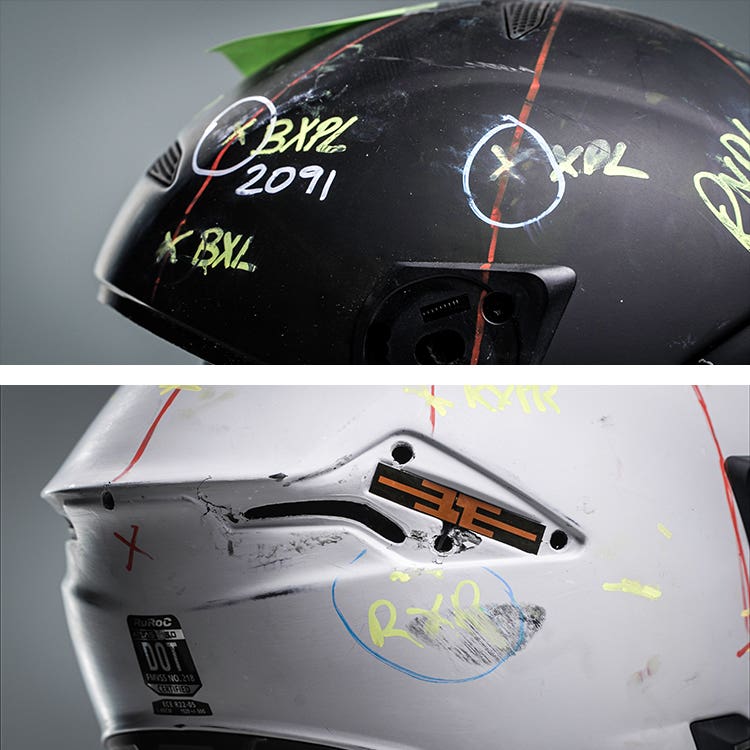ATLAS 4.0
Not only does ATLAS 4.0 meet the ECE 22.06 testing requirements, we surpass them all by a minimum of 20%
What's the best motorcycle helmet safety rating?
ECE 22.06 is the most sophisticated road helmet standard, but that is only legally applicable to EU countries. FIM is a slightly more rigorous version of the 22.06 standard, but that is only specific to track riding, and the additional aspects of it are really only relevant to high-speed riding. All of our ATLAS 4.0 motorcycle helmets have achieved the ECE 22.06 safety rating.
Every major market territory has its own respective motorcycle helmet safety certification that needs to be in place in order to legally ride on those roads. Each of these sets of tests and standards shares similarities, but also have some variations that evaluate the helmet in their own unique way.
ECE 22.06 is the standard required for motorcycle helmets in EU countries, it is the most sophisticated road helmet standard to date, with over 10 significantly different types of tests, all of which together make up the approval process.
The track riding specific FIM qualification follows the ECE 22.06 test process very closely, with slight increases to some of the test's limits, aimed at tackling very high-speed riding. This is also the same for the SHARP rating, with the exception that SHARP add a weighting factor to each impact point when calculating the overall performance. This is based on the probability of having an impact on each point, to ensure a statistically enhanced safety evaluation is delivered.
Achieving ECE 22.06 status with ATLAS 4.0 motorcycle helmet was absolutely key to us achieving our safety improvement aspirations, and in fact, we surpassed all the testing requirements by a minimum of more than 20%. Making this full-face helmet by far the safest ATLAS yet!
What makes a motorcycle helmet safe?
ECE 22.06 is the most sophisticated road helmet standard, but that is only legally applicable to EU countries. FIM is a slightly more rigorous version of the 22.06 standard, but that is only specific to track riding, and the additional aspects of it are really only relevant to high-speed riding. All of our Atlas 4.0 motorcycle helmets have achieved the ECE 22.06 safety rating.
• Linear impact absorption
A balance between stiffness and strength of the shell composition and EPS thickness and density is key to absorbing and distributing the energy attenuation during a crash. Minimising the amount that transmits through to the riders head. The ATLAS 4.0’s new three-art multi-density EPS structure takes safety performance in this area to a whole new level.
• Rotational impact absorption
Rotational impacts are proven to be a major contributor to accidents that result in permanent life-changing brain injuries. Motorcycle helmets should be designed to control this rotational acceleration to ensure that the transmissible angular force to the brain is minimised. ATLAS 4.0 uses a non-newtonian reactive polymer, RHEON, to significantly reduce this energy, resulting in a rotational impact result that surpasses the latest 22.06 requirement by more than 50%.
• Penetration resistance
Controlling the flexibility and tensile properties of the shell help to ensure that the helmet can protect the rider against sharp objects piercing through. Carbon Fibre is used for its excellent tensile strength and flexibility, while its lightweight properties ensure that the helmet remains as light as possible. Advanced composite materials, such as aramids like Kevlar, can be added to reinforce this penetration performance.
• Fit & positional stability
A snug fit with little to no rotational or linear motion of the helmet on the head will ensure that the helmet stays in place while riding (accelerations, braking, shoulder checks, cross-winds). This prevents distraction, reduced visibility, and will guarantee that the helmet is in the perfect position to maximise impact performance during a crash. The new ATLAS 4.0 liner has been tuned through user trials and wind tunnel testing to deliver enhanced fit and safety perception (snugness), which in turn results in the smoothest riding experience from our ATLAS motorcycle helmet range so far.
• Visibility
Maximising the field of view, both vertically and horizontally, ensures that the rider can see as much of the road as possible at all times. This needs to be accompanied by the ability to maintain a fog-free visor. Better visibility gives the rider more chance to spot and avoid more hazards. ATLAS 4.0 has been designed to have a field of view that exceeds the human peripheral potential, so the rider's vision is not limited by the helmet. The patented RAID system of the ATLAS helmet contributes to a self-regulating demist function. This combined with a Pinlock insert results in a fog-free ride in almost all conditions. Every ATLAS 4.0 helmet can be customised with a range of colour visors, each of the ATLAS helmet visors has been specifically designed to fit seamlessly with the ATLAS helmet.
• Robust retention
Having a strong and reliable retention system (chin strap & buckle) is essential to the safety of a helmet. The helmet MUST remain on the riders head and in position at all times. A safe retention system is one that can complete the static and dynamic retention tests of the certification standards, withstanding tears, abrasion, elongation and fraying. Each ATLAS 4.0 motorcycle helmet comes equipped with the tried and tested Fidlock buckle, which has been shown to be strong enough to lift a motorcycle off the ground, plenty strong enough for the job.
Safety is everything and testing is at the heart of what we do. See here for more information on ATLAS safety ratings and testing.
Can you add bluetooth to a motorcycle helmet?
Yes! The ATLAS Shockwave 4.0 is the perfect Bluetooth audio accompaniment to the ATLAS 4.0 full-face helmet. The Shockwave is seamlessly integrated into the helmet and connects to the world through 'Project R' - the next level in rider communication.

